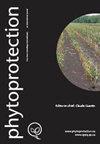Response of the Pacific Coast wireworm, Limonius canus, and the dusky wireworm, Agriotes obscurus (Coleoptera: Elateridae), to insecticide-treated wheat seeds in a soil bioassay
IF 0.2
4区 农林科学
Q4 PLANT SCIENCES
引用次数: 19
Abstract
Larvae of the dusky wireworm, Agriotes obscurus, and the Pacific Coast wireworm, Limonius canus, were exposed to germinated, insecticide-treated wheat seeds in a soil-filled bioassay in 2005 and 2006. Position in the bioassay and contact and/or repellence behaviour towards the seeds were recorded every 5 min for 3 or 5 h. Wireworm health was recorded for 70 or 126 d after exposure. Seeds were treated with the fungicides Dividend XLRTA (difenoconazole, mefenoxam) or Raxil MD (tebuconazole, metalaxyl), and/or the insecticides Vitavax Dual (lindane), Poncho 600F (clothianidin), Cruiser 350FS (thiamethoxam), Admire 240FS (imidacloprid), Gaucho 480FL (imidacloprid), Tefluthrin 20CS (tefluthrin), or Tefluthrin-Cruiser combinations. Most wireworms (> 80%) came into contact with the seeds in all treatments. Wireworms generally remained in contact throughout the observation period in the control treatments (Dividend, Raxil, untreated seeds). Unless moribund, wireworms were repelled after brief (< 20 min) contact in all Tefluthrin treatments. Most wireworms recovered from contact-induced morbidity within 21 d and did not relapse, except L. canus exposed to Cruiser and some A. obscurus exposed to Gaucho and Admire. Wireworm mortality was low (< 50%) in all treatments except L. canus exposed to Cruiser at 15 and 30 g a.i. 100 kg-1 seed (60 and 75%, respectively). Mortality was significantly less important when L. canus larvae were exposed to Tefluthrin-Cruiser combinations than when exposed to Cruiser alone. We suggest that efficacy assessments of insecticides for wireworm control require direct observation of their behaviour and long-term post-exposure health assessments, and discuss the impact of repellence and/or morbidity elicited by insecticides on wireworm control in the field.在土壤生物测定中,太平洋海岸的小线虫和暗纹线虫对杀虫剂处理过的小麦种子的反应
2005年和2006年,在一个充满土壤的生物试验中,将暗纹线虫(Agriotes obscurus)和太平洋海岸线虫(Limonius canus)的幼虫暴露在发芽的、经过杀虫剂处理的小麦种子中。在3或5小时内,每5分钟记录一次在生物测定中的位置以及对种子的接触和/或驱避行为。暴露后70或126 d记录线虫的健康状况。用杀菌剂Dividend XLRTA(二苯醚康唑,甲非诺肟)或Raxil MD(甲苯唑,甲氨苄)和/或杀虫剂Vitavax Dual(林丹)、Poncho 600F(噻虫胺)、Cruiser 350FS(噻虫嗪)、Admire 240FS(吡虫啉)、Gaucho 480FL(吡虫啉)、氟菊酯20CS(氟菊酯)或氟菊酯-Cruiser组合处理种子。在所有处理中,大多数线虫(> 80%)都能接触到种子。在对照处理(红利、拉克西、未经处理的种子)中,线虫在整个观察期间通常保持接触。除死亡外,所有氟菊酯处理的线虫在短暂(< 20分钟)接触后均被驱除。大多数线虫在21 d内从接触性发病中恢复,除暴露于Cruiser的L. canus和暴露于Gaucho和崇拜的部分A. obscurus外,没有复发。在15和30 g、100 kg-1种子处理下,除油条线虫外,其余处理的线虫死亡率均低于50%(分别为60%和75%)。与单独接触氟氯菊酯相比,联合接触氟氯菊酯对canus幼虫死亡率的影响要小得多。我们建议,对控制线虫的杀虫剂的功效评估需要直接观察其行为和长期接触后健康评估,并讨论杀虫剂引起的驱避和/或发病率对现场控制线虫的影响。
本文章由计算机程序翻译,如有差异,请以英文原文为准。
求助全文
约1分钟内获得全文
求助全文

 求助内容:
求助内容: 应助结果提醒方式:
应助结果提醒方式:


